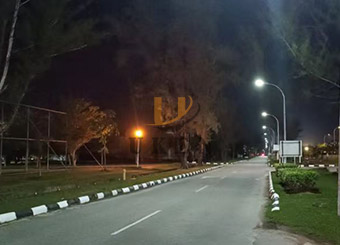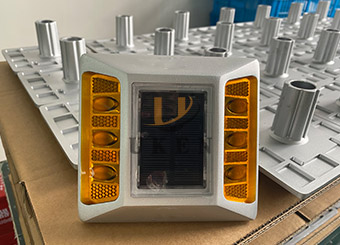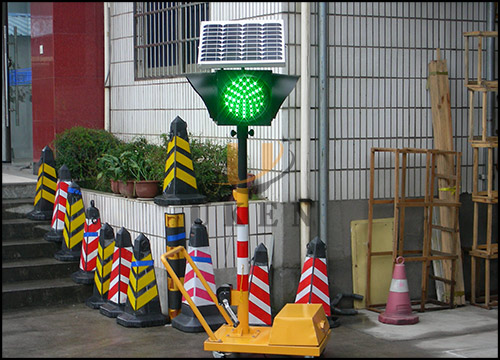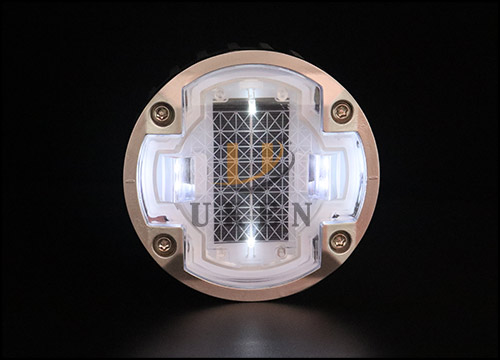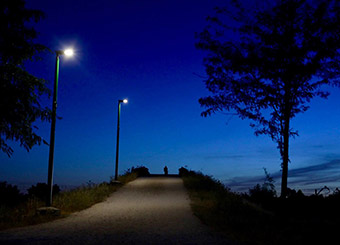Solar-powered warning lights constitute a portable core safety device that utilises solar energy to emit warning signals. In scenarios with low visibility, temporary traffic management, or areas without mains electricity supply, they effectively alert road users to potential hazards, playing a crucial role in reducing traffic accidents.
Compared to traditional wired warning lights, solar-powered warning lights offer distinct advantages: they require no mains electricity supply, eliminating the constraints of cable installation; their setup is straightforward, requiring no complex wiring operations; and they operate with zero carbon emissions, aligning with environmental principles. This core characteristic of ‘solar power supply’ enhances their applicability across diverse scenarios.
This document primarily addresses road authorities, construction teams, property management personnel, and procurement officers. By clearly outlining the fundamental information and application value of solar-powered warning lights, it provides practical guidance for equipment selection, procurement, and usage.
Solar-powered warning lights are devices that utilise photovoltaic panels to absorb solar energy, convert it into electricity for storage, and then emit flashing or steady illumination via light-emitting components. This alerts vehicles, pedestrians, or personnel to potential hazards.
(1) Hazard Warning
Used to mark hazardous zones such as roadworks, potholes, or accident sites. Its conspicuous illumination alerts passing vehicles and pedestrians to avoid collisions.
(2) Directional Guidance
In temporary traffic scenarios (e.g., road diversions, event car parks) or low-visibility conditions (night-time, fog), they guide orderly traffic flow through fixed light directions or flashing patterns, preventing disorder.
(3) Status Indication
They display operational statuses of facilities, such as the open/closed status of railway level crossings or the operational status of construction machinery, enabling personnel to swiftly grasp on-site conditions.
(1) Common Types
Monocrystalline silicon panels: High energy conversion efficiency (approximately 22%-25%), suitable for scenarios demanding high power supply efficiency, though relatively costly.
Polycrystalline silicon panels: Offer better cost-effectiveness with conversion efficiencies of approximately 18%-22%, meeting most standard usage requirements and representing one of the mainstream choices in the market.
(2) Function
As the core energy supplier, solar panels absorb sunlight and convert it into direct current (DC), providing the fundamental power for subsequent energy storage and equipment operation.
(1) Types
Lithium-ion batteries: Lightweight, long lifespan (typically 3-5 years), and high charging efficiency, suitable for scenarios requiring device portability and durability.
Lead-acid batteries: Lower cost but heavier, with a relatively shorter lifespan (2-3 years), predominantly used in fixed installations where weight is not a critical factor.
Supercapacitors: Employed in certain high-end models, featuring rapid charging capabilities and tolerance for high-temperature environments, making them suitable for regions with extreme climates.
(2) Function
Stores electrical energy converted by solar panels, ensuring warning lights remain operational during night-time or overcast conditions without direct sunlight. Typically, backup power supply duration can reach 3-7 days.
(1) Light Source
Currently, high-brightness LEDs are the mainstream choice, offering three key advantages: Firstly, low power consumption effectively conserves energy and extends operational duration; secondly, a long lifespan exceeding 50,000 hours reduces replacement frequency; thirdly, high luminosity provides visibility of 500-1000 metres in darkness, delivering significant warning effectiveness.
(2) Lighting Modes
Includes flashing (slow, fast, stroboscopic), constant illumination, and synchronised flashing (enabling uniform frequency when multiple lights operate together), allowing flexible selection based on specific warning requirements.
(1) Core Functions
Automatic Light Control: Utilises light sensors to detect ambient brightness, automatically activating lights at dusk and deactivating them at dawn without manual intervention.
Battery Protection: Features overcharge and over-discharge protection. Charging ceases when the battery is fully charged, and power is cut off when the charge level is too low, preventing battery damage and extending service life.
Mode Adjustment: Supports manual configuration of flashing frequency, brightness, and other parameters to adapt to diverse operational scenarios.
(2) Protective Design
Typically features IP65 or IP67 waterproof and dustproof ratings, withstanding rain exposure and sand ingress to ensure reliable operation in adverse weather conditions.
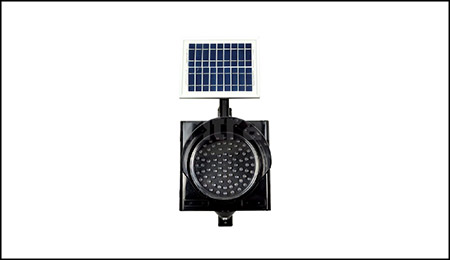
During daylight hours, the solar panel absorbs sunlight, converting solar energy into direct current (DC) electricity. This electrical energy is then transmitted to the control system.
After processing the electrical energy, the control system directs a portion to directly charge the storage battery, while another portion can directly power the light-emitting module when required (if the warning function needs to be activated during daylight hours). Simultaneously, the control system continuously monitors the battery charge level, automatically halting charging once fully charged to protect the battery.
The battery continuously stores electrical energy during daylight hours, reserving power for night-time or periods without sunlight. Even during daylight, should cloud cover suddenly obscure the sun, the stored energy ensures the warning lights can operate briefly, preventing interruption of the warning due to sudden changes in light levels.
When ambient light dims (e.g., at nightfall), the light sensor signals the control system to switch to battery power mode, supplying electricity to the light-emitting modules.
The light-emitting modules operate according to pre-set lighting patterns (flashing or steady) to emit warning light. When multiple warning lights are used in coordination, the control system can synchronise flashing via wireless connection, enhancing overall warning effectiveness.
(1) Pole-Mounted Solar Warning Lights
Requiring installation on utility poles, guardrails, or dedicated brackets, these are suitable for fixed placement along road edges, construction perimeter boundaries, railway crossings, etc. They offer high stability and a broad warning coverage area.
(2) Ground-mounted solar warning lights
Placed directly on the ground, some models feature weighted bases or fixed spikes for secure anchoring. Used to mark road potholes, temporary construction boundaries, etc., they offer straightforward installation without occupying overhead space.
(3) Magnetic Solar Warning Lights
Equipped with powerful magnets for direct attachment to vehicle surfaces (e.g., construction trucks, emergency response vehicles). Exceptionally flexible for mobile operations, such as temporary accident site warnings or mobile construction crew alerts.
(1) Red Solar Warning Lights
Representing the highest alert level, these mark critical hazard zones such as accident scenes, closed road entrances, or temporary hazardous goods transport stops. They rapidly trigger road users’ instinct to ‘stop or yield’.
(2) Yellow / Amber Solar Warning Lights
Primarily used to indicate potential hazards or temporary traffic changes, such as roadworks sections, vehicle diversion zones, and car park entrances/exits. These remind vehicles and pedestrians to slow down and remain vigilant.
(3) Blue Solar Warning Lights
Primarily for emergency or official use, such as auxiliary warnings for emergency vehicles (police cars, fire engines, etc.) or marking critical facilities like fire hydrants and emergency access points. These lights symbolise authority and priority.
Entirely powered by renewable solar energy, eliminating grid electricity consumption. This reduces operational costs, minimises carbon emissions, aligns with global green development trends, and suits projects or areas with stringent environmental requirements.
Requiring no power line installation, whether pole-mounted, ground-embedded, or magnetically attached, individual units typically take 10-15 minutes to install. This proves particularly advantageous in remote, off-grid areas (e.g., mountain roads, rural construction sites) or temporary scenarios (e.g., short-term event traffic management).
Housings predominantly utilise ABS engineering plastic or aluminium alloy, offering UV resistance and corrosion protection while withstanding extreme temperatures from -30°C to 60°C. Long-life LED sources and batteries minimise replacement frequency; routine maintenance requires only periodic cleaning of solar panels to ensure optimal energy absorption efficiency, resulting in low overall upkeep costs.
Exceptional waterproofing and dust resistance ensure operation during heavy rain, snowfall, and sandstorms. Sufficient battery backup duration maintains warning functionality even during 3–7 consecutive days without sunlight, making it suitable for regions with complex and variable climates.
Roadworks: Marking construction zone boundaries to alert vehicles to decelerate and detour in advance, safeguarding both workers and passing traffic.
Temporary Traffic Management: For lane closures during road repairs or load-restricted bridge inspections, warning lights clearly delineate controlled areas and designated routes.
Hazardous Sections: Installed at accident-prone locations like bends, gradients, and tunnel entrances/exits to alert drivers to road conditions at night or in adverse weather.
Pedestrian Safety: Installed near schools and community crossings to alert vehicles to yield to pedestrians, proving particularly effective during morning and evening rush hours.
Used to demarcate construction site boundaries, crane operating radii, and material storage areas, preventing unauthorised personnel from entering hazardous zones. Simultaneously, it directs on-site vehicles to maintain orderly movement, minimising collision risks.
Following traffic incidents, solar warning lights can be rapidly deployed to cordon off accident sites and prevent secondary collisions. During disasters such as fires or floods, they mark rescue routes and hazardous zones, guiding emergency personnel and trapped individuals to safety.
Railway crossings: Alert vehicles and pedestrians to approaching trains, particularly at unmanned crossings, supplementing traditional warning systems.
Car parks: Guide vehicle entry/exit, delineate parking bays or mark turning points in access routes to improve parking order.
Schools and communities: Installed in school construction zones or community renovation areas to safeguard student and resident movement.

For roadworks or hazardous sections, prioritise high-brightness red or amber warning lights with extended visibility (500 metres+), ensuring long-range warning effectiveness.
For vehicle mounting, choose magnetic, compact, portable models for easy removal and relocation.
For remote, off-grid locations with frequent overcast or rainy conditions, select products with a battery backup duration exceeding five days and high solar panel conversion efficiency.
Solar Panel Efficiency: For high power supply stability, opt for monocrystalline silicon panels; polycrystalline silicon panels offer cost-effective solutions where efficiency demands are lower and budgets are constrained.
Battery endurance: Select models with backup durations matching local rainy season lengths to prevent warning interruptions due to depleted power.
Protection rating: IP67-rated products are essential in rainy or dusty regions; IP65 suffices in temperate climates.
Select products certified to international standards such as CE and RoHS, or compliant with local traffic regulations (e.g., US FHWA standards). This ensures equipment quality conformity while mitigating usage risks or regulatory issues arising from non-compliance.
Operating on the principle of ‘solar collection → energy storage → warning illumination’, solar-powered warning lights deliver energy-efficient, flexible, and reliable safety alerts. They safeguard lives and traffic order across multiple domains including road transport, construction sites, and emergency response operations.
Road Authorities: Eliminates the need for power line installation, reducing both initial setup and ongoing maintenance costs while enhancing road safety management efficiency.
Construction Teams: Rapid deployment and flexible mobility enable swift establishment of on-site safety warning systems, safeguarding workers.
Procurement Personnel: Energy-saving features lower long-term operational costs, while robust durability minimises replacement expenditure, offering a cost-effective and practical solution.
Should you require bulk procurement of solar warning lights or bespoke solutions (e.g., specific lighting modes, installation methods), please contact our specialist team. We supply premium solar warning lights with a two-year warranty, complemented by on-site installation guidance to ensure optimal performance, safeguarding your safety requirements.
